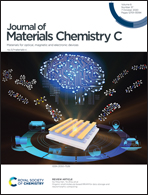A printable thermally activated delayed fluorescence polymer light emitting diode†
Abstract
Amongst emissive materials for organic light emitting diodes (OLEDs), thermally activated delayed fluorescence (TADF) materials have shown substantial promise in the last few years. For OLEDs, solution processable and printable emissive materials are highly desirable as printing allows for precise patterning without masks, enables deposition of nanometer scale thicknesses and results in minimal wastage of material. Herein, we introduce a solution processable TADF emitting polymer as an emissive material for OLEDs. The bespoke polymer structure features the TADF emitter 4-(9H-carbazol9-yl)-2-(3′-hydroxy-[1,1′-biphenyl]-3-yl)isoindoline-1,3-dione as a pendant group on a poly(methyl methacrylate) based polymer chain. The resulting OLEDs have a peak emission wavelength of 520 nm with a maximum luminance of around 4700 cd m−2. The peak emission wavelength can be blue-shifted by exciplex management to achieve a peak wavelength of 494 nm. Critically, we employed the TADF-containing polymer system to ink-jet print OLEDs, demonstrating that such polymers are viable for printable OLEDs.



 Please wait while we load your content...
Please wait while we load your content...